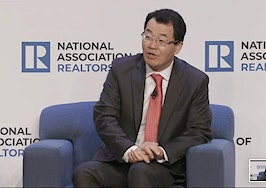New markets require new approaches and tactics. Experts and industry leaders take the stage at Inman Connect New York in January to help navigate the market shift — and prepare for the next one. Meet the moment and join us. Register here.
Although home prices are expected to fall as much as 8 percent next year, rising mortgage rates, inflation, a mild recession and other economic headwinds will prevent homebuyers from seeing the difference in their pockets, according to a new analysis by independent research firm Capital Economics’ latest U.S. Housing Market Outlook.
The London-based firm said a continued surge in interest rates will push the U.S. into a “mild recession” during the first quarter of 2023, as the Federal Reserve works to bring inflation back to a normal level by Q4 2023. In the meantime, Capital Economics said businesses will continue their cost-saving measures, which means raising sales prices and cutting workforces.
“Given that we are unlikely to see an improvement in affordability anytime soon, many buyers will be priced out of the market, while others will simply be unwilling to make a purchase,” states the news analysis, published earlier this month. “As bidders become scarcer, market power will shift further from sellers to buyers.”
“We expect the Fed’s aggressive monetary tightening will push the headline inflation rate below the 2 percent target by mid-2023,” Capital Economics Property Economist Sam Hall added. “Core inflation has proved more persistent, ticking higher in Q3 on the back of rising [home] prices.”
“But with the pressures from goods shortages already fading and rising unemployment likely to push wage growth lower, core inflation will soon begin to fall sharply as well,” he added.
All of these macroeconomic factors will weigh on sales in 2023, Hall said, with current mortgage rates erasing the benefit of declining home prices. For a median-income household purchasing a median-priced home, the boom in mortgage rates from May 2020 to October 2022 chopped their buying power almost in half with mortgage payments as a share of income rising from 13.3 percent to 28.5 percent — the worst since 1985.
Hall said this will be the landscape for homebuyers through the majority of 2023 until mortgage rates fall to the five-percent range during Q4. The decrease in mortgage rates and home prices will offer some relief, with the report forecasting mortgage payments as a share of income falling from October’s 37-year high of 28.5 percent to approximately 22 percent by Q4 and 20 percent by Q2 2024.
Although that will give a much-needed boost to well-financed and experienced buyers, Hall said it won’t do much for first-time buyers with lower incomes and less-than-perfect credit histories.
“This will shut many first-time buyers out of the market, causing the homeownership rate to stall,” he said. “The extent to which stretched affordability impacts demand is also dependent on what happens to credit conditions. But with house prices falling, we doubt banks will loosen conditions over the next year.”
With weak housing starts, lackluster existing-home inventory growth and fickle buyer demand, the report said home sales will have a slow start in 2023 as consumers stay on the sideline and wait for better conditions.
“High interest rates will discourage many homeowners from moving house for fear of losing their current interest rate, so the rise in existing inventory is likely to be modest,” the report read. “Falling sales will also lead to a rise in the number of new homes for sale in the near-term. But new inventory will soon fall sharply as completions slow.”
Hall said 2022 existing-home and new-home sales will fall on an annualized basis to 4.2 million and 450,000, respectively. However, 2023 existing-home sales are expected to close at 4.5 million before reaching 5.0 million in 2024. New-home sales will follow a similar trajectory, the report said.
For would-be buyers who find themselves locked in the rental market, they’ll find a more prickly affordability landscape with asking rent as a share of their income up from 37 percent in Q1 2021 to 42 percent in Q3 2022. However, that share is expected to drop in 2023 as annual rent growth drops to 0.5 percent before rebounding to 1 percent in 2024.
“The big picture is that affordability will be stretched for most of next year,” the report said.













